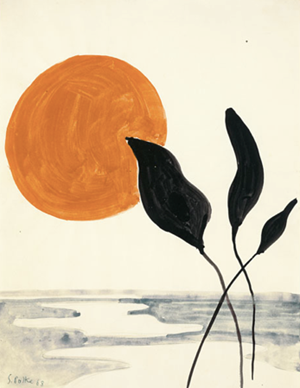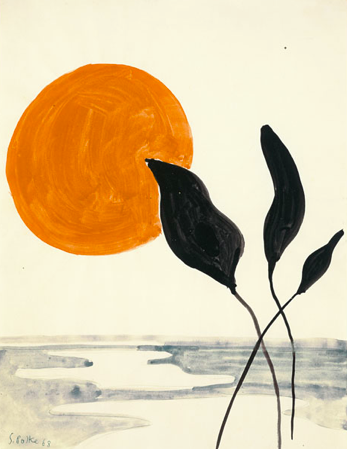
The Harvard Art Museums announced an extraordinary gift of nearly 50 works by major figures in postwar German art from the collector Dorette Hildebrand-Staab, a member of the German Friends of the Busch-Reisinger Museum. The works include drawings by Georg Baselitz, Joseph Beuys, Antonius Höckelmann, Jörg Immendorff, Imi Knoebel, Sigmar Polke, and Eugen Schönebeck and others.
Image: Sigmar Polke, Untitled (schwarze Halme vor Sonne), 1965. © The Estate of Sigmar Polke, Cologne/ VG Bild-Kunst, Bonn 2016
Dating roughly from the 1950s to 1980s, these works were made when many of these now-renowned artists were students at the Hochschule für Bildende Künste in Berlin or the Düsseldorf Art Academy. In addition to the postwar works, a selection of late 18th- to early 19th-century etchings by German printmaker Carl Wilhelm Kolbe are also part of the gift.
“Dr. Hildebrand-Staab often purchased works directly from artists—Baselitz in particular, whose work she first saw in 1965,” said Lynette Roth, the Daimler Curator of the Busch-Reisinger Museum and Head of the Division of Modern and Contemporary Art. “Her gift thus offers evidence of a collecting practice around many of these artists as they emerged in Germany in the 1960s, long before they became known to American audiences in the early 1980s through New York gallery shows and museum exhibitions.”
Born largely during World War II and coming of age in the 1960s, the artists represented in the gift were among the first to deal directly with their country’s fascist past. They did so often via provocative, perverse, or humorous subject matter. In 1961/62, for example, Baselitz and Schönebeck closely collaborated on their Pandemonium Manifestos, lurid surrealist tracts that, like their imagery at that time, criticized German postwar society for suppressing the horrors of the Nazi period and the Holocaust.
According to Hildebrand-Staab, the gift is offered as a “bridge between the United States and Germany, in gratitude for American support of the country after 1945, but also to remind new generations of this longstanding relationship.”
The artworks build directly on Hildebrand-Staab’s earlier gift of a 1964 painting by Baselitz Saxon Motif as well as two drawings (by Baselitzand Penck), donated as part of the Friends Anniversary Collection, a 2008 initiative designed to strengthen the Busch-Reisinger Museum’s holdings of art made after 1960. The Busch-Reisinger Museum is dedicated to the study of all modes and periods of art from central and northern Europe, with an emphasis on German-speaking countries.
The current gift includes the first works by Schönebeck to enter the museums’ collections. Two early drawings by Beuys—one from 1949, while he was a student at the Düsseldorf Art Academy—complement the Busch-Reisinger’s near-complete collection of the artist’s editioned artworks, or multiples. Works by two of Beuys’s students in Düsseldorf—subtle geometric forms by Imi Knoebel, and three satirical missives by Jörg Immendorff—are the first drawings by these artists to enter the collections.

Sigmar Polke, Untitled (schwarze Halme vor Sonne), 1965. © The Estate of Sigmar Polke, Cologne/ VG Bild-Kunst, Bonn 2016
Works by Polke in the current gift, including five drawings from the mid- to late 1960s and the 1968 portfolio Higher Beings Command, comprising fourteen offset lithographs and four unique drawings, notably expand the Museum’s holdings of German pop art. Polke’s critiques of the so-called West German “economic miracle” and the country’s rampant consumerism are drawn on paper from a standard, inexpensive writing pad. Often employing the vernacular of cartoons and comic strips, Polke’s technical approach was deliberately crude; akin to Immendorff’s preference for colored markers, Polke used ballpoint or felt-tipped pens. In a work in graphite and watercolor from 1968, Polke takes on “modern art,” poking fun at the abstraction that had dominated the West German art scene since the first documentain 1955.
“Dr. Hildebrand-Staab’s continued generosity and support of the Busch-Reisinger Museum will greatly benefit students, scholars, and visitors from around the world,” said Martha Tedeschi, the Elizabeth and John Moors Cabot Director of the Harvard Art Museums. “This significant gift broadens our collections and provides further opportunities for study and appreciation, integral to our teaching and research mission.”

ArtDependence Magazine is an international magazine covering all spheres of contemporary art, as well as modern and classical art.
ArtDependence features the latest art news, highlighting interviews with today’s most influential artists, galleries, curators, collectors, fair directors and individuals at the axis of the arts.
The magazine also covers series of articles and reviews on critical art events, new publications and other foremost happenings in the art world.
If you would like to submit events or editorial content to ArtDependence Magazine, please feel free to reach the magazine via the contact page.